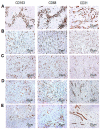Inhibiting Monocyte Recruitment to Prevent the Pro-Tumoral Activity of Tumor-Associated Macrophages in Chondrosarcoma
- PMID: 32344648
- PMCID: PMC7226304
- DOI: 10.3390/cells9041062
Inhibiting Monocyte Recruitment to Prevent the Pro-Tumoral Activity of Tumor-Associated Macrophages in Chondrosarcoma
Abstract
Chondrosarcomas (CHS) are malignant cartilaginous neoplasms with diverse morphological features, characterized by resistance to chemo- and radiation therapies. In this study, we investigated the role of tumor-associated macrophages (TAM)s in tumor tissues from CHS patients by immunohistochemistry. Three-dimensional organotypic co-cultures were set up in order to evaluate the contribution of primary human CHS cells in driving an M2-like phenotype in monocyte-derived primary macrophages, and the capability of macrophages to promote growth and/or invasiveness of CHS cells. Finally, with an in vivo model of primary CHS cells engrafted in nude mice, we tested the ability of a potent peptide inhibitor of cell migration (Ac-d-Tyr-d-Arg-Aib-d-Arg-NH2, denoted RI-3) to reduce recruitment and infiltration of monocytes into CHS neoplastic lesions. We found a significant correlation between alternatively activated M2 macrophages and intratumor microvessel density in both conventional and dedifferentiated CHS human tissues, suggesting a link between TAM abundance and vascularization in CHS. In 3D and non-contact cu-culture models, soluble factors produced by CHS induced a M2-like phenotype in macrophages that, in turn, increased motility, invasion and matrix spreading of CHS cells. Finally, we present evidence that RI-3 successfully prevent both recruitment and infiltration of monocytes into CHS tissues, in nude mice.
Keywords: cell migration inhibitors; chondrosarcoma; monocytes; tumor-associated macrophages.
Conflict of interest statement
The authors declare no conflict of interest.
Figures







References
-
- Hogendoorn P.C.W., Bovée J.V.M.G., Nielsen G.P. WHO Classification of Tumours of Soft Tissue and Bone. 4th ed. HWO Press; Geneva, Switzerland: 2013. pp. 264–268.
-
- van Maldegem A., Conley A.P., Rutkowski P., Patel S.R., Lugowska I., Desar I.M.E., Bovée J.V.M.G., Gelderblom H. Outcome of First-Line Systemic Treatment for Unresectable Conventional, Dedifferentiated, Mesenchymal, and Clear Cell Chondrosarcoma. Oncologist. 2019;24:110–116. doi: 10.1634/theoncologist.2017-0574. - DOI - PMC - PubMed
-
- Miao R., Choy E., Raskin K.A., Schwab J.H., Nielsen G.P., Deshpande V., Chebib I., DeLaney T.F., Hornicek F.J., Cote G.M., et al. Prognostic Factors in Dedifferentiated Chondrosarcoma: A Retrospective Analysis of a Large Series Treated at a Single Institution. Sarcoma. 2019;2019:9069272. doi: 10.1155/2019/9069272. - DOI - PMC - PubMed
Publication types
MeSH terms
Substances
LinkOut - more resources
Full Text Sources

